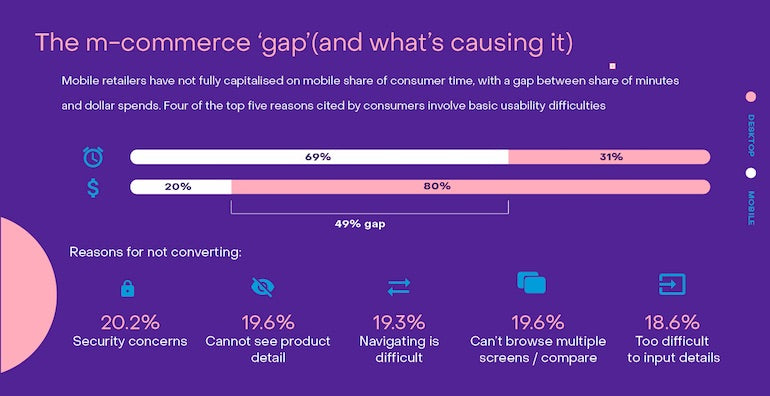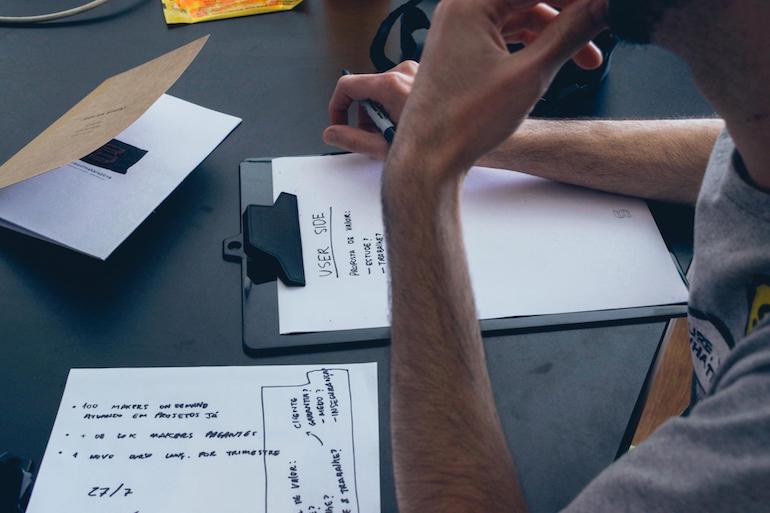Commerce has been a predominant facet of humanity ever since prehistoric people started bartering goods and services. Fast-forward 150,000 years and commerce is still evolving, perhaps faster than ever. Mobile commerce is just one facet of this new wave.
Now, commerce is facing the perfect storm of digital disruption: an explosion of consumer touchpoints and choices colliding with an inversely proportional downsizing of screens and interfaces.
Mobile commerce is the new heartbeat of the customer journey
Mobile commerce (M-commerce) is not only shaping new customer expectations, but it’s also transforming customer experience (CX) altogether. As the rules of CX get reinvented, so does our website builder UX-UI design playbook.
In the age of “nanodesign”—where shopping interfaces keep getting smaller every day—designers (and businesses) need to do more with less. Their task: create value-added experiences while subtracting pixels and focusing on crafting meaningful one-to-one relationships.
One-size-fits-all interfaces don’t cut it anymore. Personalization at scale has become the new holy grail, especially as the very definition and scale of “The Retail Store” have shifted.
For designers, developers, and their ecommerce merchant clients, a changing playing field means new design principles, new interfaces, but most importantly: new business models.
To adapt our playbook, it’s important to first analyze the driving forces (and tensions) that impact interface design both on a large scale and nanoscale. Let’s jump right in.
Consumers don’t want more choices—they want to be more confident in the choices they make.
Shortened attention span vs. heightened expectations

Whether the myth is true or not (it’s been said that we now have a shorter attention span than goldfish), one thing is for sure: our tech addiction combined with an infinite pool of choices has turned shopping into an extremely volatile and complex experience.
The burden of simplifying the customer journey should fall on businesses and their UX designers, not on the end consumer. Too many businesses still force their customers to adapt to their pace of play, instead of the other way around. The big winners of the digital world understand that designing frictionless customer experiences is the only path forward.
It’s not that consumers’ brains have been fried by the blue light of their phones to the point where they can’t sustain a few seconds of focused attention (at least not yet!)—but it’s fair to say that attention has become the ultimate digital currency.
For brands, it’s never been harder to gain it and maintain it.
You might also like: 10 Ecommerce Trends That Will Set Your Client’s Brand Apart in 2020.
As a business owner or designer, you need to earn it by creating a delightful experience centered around consumers’ personal needs, preferences, and expectations. That’s how you turn seconds of engagement into minutes, minutes into transactions, and transactions into lasting relationships.
In this hyper-competitive and fragmented ecommerce landscape, consumers are generally overwhelmed by choice and underwhelmed by service. As a result, they expect more curation, education, and personalization from the brands they buy from.
The Ubers, Netflixes, and Amazons of this world have set the new standard in terms of customer experience, and this has contributed to elevated expectations. By reducing friction at every turn and making everything readily available at our fingertips, they’ve earned our loyalty and our wallets.
What is true for digital distribution is true for retail and ecommerce. Whether you are selling t-shirts, tartan accessories, breastfeeding pumps, monocycles, or anything in between, you need to abide by the same rules. Today’s consumers expect speed, ease, convenience, always-on availability, and personalization.
Brands that check these boxes have a much rosier future than their traditional retail store counterparts who keep closing at a breakneck pace.
For designers, it means transcending the interface to focus on the interaction. The interface is the vehicle of value creation; the means to an end. The end goal is designing a delightful customer journey with interactions that are frictionless and customers that stay engaged, captive, and loyal.
Shrinking interfaces vs. infinite choices
Smartphones are the new storefronts. In a flick of the finger, consumers can go from Store A, to Store B, to Store C, and never look back. It’s almost as if consumers now have an entire mall in the palm of their hands.
As aisles get replaced by countless pages and dropdown menus, the overall shopping experience can end up being squeezed and diminished. It’s no surprise then that the average conversion rate in a physical retail store (typically over 20 percent) is 10 times higher than the conversion rate of the average Shopify store (1.5 percent).

Despite all its advantages, ecommerce converts less because it still feels less personal, and because of the low barrier to browsing. At times, the customer experience can feel like trying to find a needle in a haystack, infinitely scrolling through a gigantic product catalog on a small screen.
What it means for designers is that we now need to find new ways to store thousands of product SKUs inside a six-inch screen and make them easily accessible. That has been no small feat historically, causing the great “mobile commerce gap.”
ComScore’s Mobile Hierarchy of Needs’ Report describes it as “retailers’ inability to capitalize on the mobile share of consumer time, with a gap between the share of minutes and dollar spend.”
Four of the top five reasons cited by consumers for not making a purchase revolved around the sub-par experience on mobile, including deficiencies in browsing and product discovery.
"Four of the top five reasons cited by consumers for not making a purchase revolved around the sub-par experience on mobile, including deficiencies in browsing and product discovery."

The net takeaway is clear: we must rethink the browsing experience to facilitate product discovery and ease transactions at the smallest scale.
From smarter search filters using machine learning, to dynamic product display personalization, to deploying a virtual customer assistant that guides customers via live chat, there are many tactics ecommerce store designers and developers can use to augment the mobile experience and reduce the impact of smaller screen sizes on conversion rates.
In the end, the goal is to amplify the inherent strengths of mobile (always-on, contextual, conversational, social, personal, etc.) to recreate the level of interactivity and assistance consumers typically got in-store when chatting with an associate, and therefore dramatically boost conversion rates.
Dematerialized stores vs. multiplied touchpoints

The new customer journey is unpredictable and non-linear. It’s hyper fragmented and hard to track. A shopper might start browsing dresses on a mobile site, then text a friend for a recommendation, then get retargeted a few hours later by a Facebook ad.
Each touchpoint represents a critical interaction that can make or break the sale and impact brand affinity. As such, these interactions should no longer be viewed as separate but rather as a continuum. In light of COVID, the rise of contactless commerce is inevitable. As such, the "retail store" is increasingly becoming a digital, and sometimes invisible, experience. The “Store of the Future” is both invisible and infinite because shopping can happen anywhere, anytime. It has no border; no wall. It’s infinitely small and powerful at the same time.
"The “Store of the Future” is both invisible and infinite because shopping can happen anywhere, anytime."
Conversational interfaces like voice and chat assistants are contributing to the dematerialization of the store. Natural language is perhaps the most frictionless shopping interface ever, and people typically gravitate toward the path of least resistance. So much so that some parents, to their dismay, received unexpected packages at their doorstep thanks to their kids’ impulse buys like cookies and dollhouse purchases via Amazon Alexa.
For traditional designers who put an emphasis on aesthetics, the rise of conversational interfaces can be daunting because they push the traditional graphical interface into the background. That said, it should be seen as a formidable opportunity to enhance, humanize, and fluidify ecommerce.
You might also like: Creating User Centered Flows in Ecommerce Design.
In the future, we’ll see new combinations of graphical and conversational user interfaces (GUIs and CUIs) emerge to create more seamless, adaptive, and interactive shopping experiences that transcend channels.
Nanodesign thinking revolves around focusing on the smallest interface first (it may be invisible), and working backward to make sure all the interactions are consistent across touchpoints. The best UX design is both invisible and omnipresent, or as we like to call it, ambient. It’s there to serve customers on-demand, without interruption.
Granular personas vs. big data
In 2019, Google conducted 4.5 million searches at any given minute. In this world of exponential datasets, it’s easy to lose sight of the end consumer and focus our design efforts on aggregated patterns and common denominators.
As mentioned earlier, the new consumer expects a more tailored one-to-one relationship, as opposed to one-size-fits-all, pre-baked experiences.
So the challenge here is to distill this ocean of information to resurface the smallest possible data in the right context at the right time in order to create more personalized shopping experiences.
With the rise of deep learning and AI, crunching customer data in real-time is no longer just a fluffy concept—it’s a prerequisite. Small improvements in personalization can dramatically boost a Shopify store’s conversion rate, especially if you manage to adapt the browsing experience at the individual level.
You might also like: The AI-Empowered Marketer: How Artificial Intelligence Can Help You and Your Clients Increase Sales.
What’s more, conversational channels (like webchat) and customer authentication (like loyalty program opt-ins) can help unlock a trove of declared first-party data. In the post-cookie era that we will soon be entering, this will become a lasting competitive advantage for brands that have effectively nurtured direct-to-consumer channels and harvested precious individualized data.
The holy grail here is creating a deep understanding of each customer’s intents and preferences by cultivating a 360 degree single view of the customer across channels.
In the end, AI is just a shiny object if it is not put at the service of customers.
At my company, we like to say AI should stand for "Actionable Insights," meaning it should help businesses resurface contextual information in real-time to offer a VIP experience at scale. That’s how you go one step further: from personalization to personalization.
"AI should stand for "Actionable Insights," meaning it should help businesses resurface contextual information in real-time to offer a VIP experience at scale."
Think small
In the age of mobile commerce, the “e” in “ecommerce” should stand for “effortless.”
World-class designers understand that great design is about subtracting, not adding. It’s about removing friction and unlocking instant value for whoever, whenever, and wherever.
Every interaction should require as little effort as possible. In the age of nanodesign, it’s up to us designers to do the heavy lifting, not the users.
The good news: minimal customer effort inevitably leads to maximized lifetime value. According to Siegel+Gale—a global brand strategy and experience firm that publishes a Global Brand Simplicity Index every year—it pays to keep things simple and frictionless. Their last report states that 55 percent of consumers are willing to pay more for simpler experiences, while 64 percent are more likely to recommend a brand because it provides simpler experiences and communications.
In fact, the Top 10 companies of their Brand Simplicity Index have outperformed the major indexes like the S&P 500 by 679 percent.
Making things more frictionless and simple requires obsessive attention to detail. But in the end, it’s all worth it. Thinking small will make you win big.
Here’s to making commerce better for everyone.
What are your experiences with mobile commerce and UX design? Let us know in the comments below.









